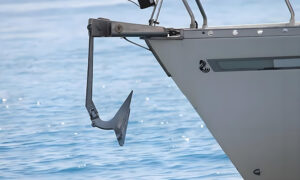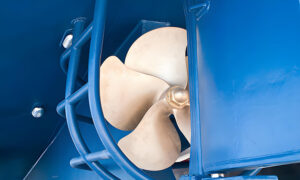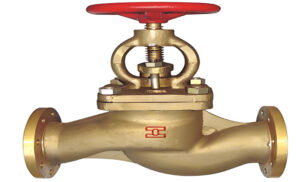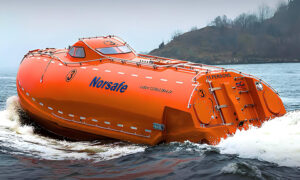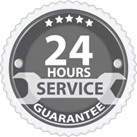What is the mooring of a ship?
Mooring comes in many forms, the most common being quay mooring, while other types of mooring are: Ship to ship (STS) attached to adjacent ships, attached to a single buoy or Single point moorings (Single point moorings, abbreviated as SPM) on the structural frame and buoy moorings (Multi-buoy moorings, abbreviated as MBM) connected to multiple buoys.
The way of mooring the ship varies with the size of the ship and the situation of the dock. There are usually three mooring methods.
1. Side mooring
Side mooring is the most common mooring method by mooring the side of the ship against the dock or other ships. When mooring on the side, the number of ropes depends on the external force on the ship. When there is no wind and waves, you only need to bring the head and tail inclined cables. If there is the effect of water flow, you need to add a reverse cable. If the influence of wind and current is greater, in order to prevent the ship from moving along the shoreline or leaving the shoreline, additional cables should be installed at the fore, aft and middle of the ship. When there are strong currents and headwinds, it is necessary to break down to assist.
2. Stern mooring
Stern mooring is a mooring method for mooring the stern end of the ship to the dock. It is generally used when the length of the shoreline of the wharf is limited. When multiple ships are moored side by side, simultaneously make lateral tie between each ship. When the wind and current are strong, the anchor can be dropped at the bow to assist. For ship formations, stern mooring is beneficial for emergency sailing. Some river boats and ferries often use stern mooring.
3. Fore and aft mooring
The boat is tied to buoys in the harbor or in the river using the bow and stern cables.
Definition of Marine Mooring Equipment
A device for mooring a boat to a dock, shore, pontoon, dock or other vessel. Usually refers to the mooring and mooring machinery.
In addition to anchoring the ship, all docks, docks, and mooring buoys must be anchored with cables. All devices and machinery that ensure the safe and reliable mooring of the ship are collectively referred to as mooring equipment.
Ships are anchored to predetermined waters or moored to docks by means of mooring equipment. Mooring equipment usually includes mooring ropes, buoys, mooring docks, bollards, fairleads, cable reels and mooring machinery required by the shore or other ships.
Moorings are usually arranged on the bow, stern or side of the deck. Generally, the left and right are symmetrically arranged to ensure that both sides of the ship can be docked. The bollards are close to the ship’s side, with a pair at the bow and stern. Fairleads and fairleads should be arranged corresponding to the bollards. All ships passing through international waterways such as the Panama Canal are also required to be equipped with special fairleads and fairleads as required. The cable reel should be arranged close to the fore and aft bulkheads so as not to obstruct the passage of personnel and to facilitate the operation of the cable take-up.
Composition of marine mooring equipment
In addition to the mooring line, the mooring equipment is also composed of a cable pulling device, a fairlead device, a mooring machine, a cable car and ancillary equipment. The picture on the left shows the layout of the bow mooring equipment for large ships.
1. Cable pulling device
In order to fix one end of the cable during berthing and towing operations, there are bollards for pulling the cable on the bow and poop deck and the midship deck. The bollards are subjected to great force, so the foundation must be very firm, and the decks near the bollards need to be strengthened.
The bollards are cast or welded with steel plates. There are many types, including single-column bollards, double-column bollards, single-cross bollards, double-cross bollards, inclined double-column bollards and claw bollards. Large and medium-sized ships mostly use double-column bollards.
2. Fairlead device
In order to make the cable lead from inboard to outboard in a certain direction to the dock or other mooring location, limit its position deviation, minimize the wear of the cable and the side, and avoid increasing the stress due to sharp bending, There are fairleads at the bow and stern and on both sides.
3. Cable winch
The winch, also known as the mooring winch, is mainly used for winding the cable. The bow winch is generally carried out by the windlass reel, and some large ships also have a special mooring winch at the bow; the cable in the middle of the ship is generally wound by the auxiliary reel of the crane, and some large ships also have a special mooring winch in the middle; A mooring winch or mooring winch is provided on the stern deck.
4. Cable car and ancillary equipment
Including cable car, rope making, cable skimming, fender, rat guard, cable skimmer, etc.
Mooring Line
Mooring rope refers to the rope used for mooring or towing the top formation of ships. According to the material, there are steel cables, chemical fiber cables, brown cables, composite cables, etc. All types of ships must be equipped with mooring cables of a certain length, quality and quantity in accordance with the regulations.
Mooring Buoy
A mooring buoy is a floating mooring device located in waters. There are single buoy mooring and double buoy mooring. Generally, it consists of three parts: buoy, anchor chain and anchor. The buoy is a sealed steel buoy, which is currently used in the shape of a drum or a cone. The buoy has certain buoyancy and anti-sinking properties, and can ensure that it floats on the water surface under the action of the self-weight of the cylinder, the weight of the anchor chain and the staff with the cable. The interior of the cylinder is divided into several compartments, when one or several of the compartments are damaged and flooded, the cylinder can still float on the water surface. The top of the pontoon is provided with mooring rings and steel shackles for mooring lines. The buoy is anchored to the bottom of the water with anchor chains and anchors. Anchor chains are generally steel chains. The anchors are cast iron sinkers or frog-shaped anchors or sinkers of reinforced concrete.
Mooring Attachments
Includes skimmers, fenders, lanyards or chains, and mouse guards. The skimming rope is a thin rope with a length of about 40m and a diameter of about 6mm. The front end of the rope is a skimmer with a certain weight. When the ship is docked, it is thrown from the ship to the wharf cable workers as an index rope for sending cables to the wharf. The fender, commonly known as the handle, is woven with rope and filled with spherical objects of soft materials such as cork or brown silk. Rope or chain is a special rigging used to temporarily tie a knot on the mooring line to withstand the tension of the rope when the ship is moored. It is made of thin steel plate or plastic plate. When the ship is moored to the pier, in order to prevent rodents from traveling along the cable, the mouse plate should be hung after the mooring cable is finished.
Check And Maintain Mooring Equipment
Every quarter, the winch and cable car should be inspected, including the rust of the outer shell foot bolts and brackets, the damage of the reel, wear and corrosion, the watertightness of the control controller, whether the rotating parts are light and flexible, brakes and Whether the clutch is feasible and light, and lubricated, make a record of wear and tear. If fitted, automatic tension winches should be checked for effectiveness. For steel wire cables, check the rust and broken wires, as well as the oil content of the linoleum core in the rope; for plant fiber cables, check their wear and tear and whether there is mildew in the strands; for synthetic fiber cables, check their surface wear and thickness. .
Every six months, check the rust and wear of the bollards, fairleads, fairleads and guide rollers, as well as the cable reel, whether there are cracks, whether the rollers are loose, and check and record the rust of the feet and the rot of the skids. , the rotating part should be refueled regularly, and its records should be made.
Each voyage, the cable-making device should be checked once, the deck eye ring should be checked for corrosion and wear, and the chain (cable) should be checked for deformation, corrosion and wear, and the rust and paint should be removed in time. Those with serious wear and deformation should be replaced. At ordinary times, you should also check the wear, corrosion and broken wires of the cables frequently, and check whether the skimming cable, the handle and the anti-rat board are complete and damaged. If they are damaged or lost, they should be replaced and supplemented in time.
The repaired winch shall be tested, and the running test shall be carried out for 1-2 hours, and the rotational speed and tensile load shall be measured. The speed of the stranding cable should be able to reach 15m/min, and the pulling force of the stranding cable should be able to reach about 75% of the breaking force of the configured mooring cable. During the test, the braking and overload protection device tests should also be carried out.
Mooring Installation Inspection
1. Conditions that should be met before installation
(1) Mooring equipment such as bollards, fairleads, fairleads, etc., are currently mostly welded with steel plates or welded and fixed by steel castings, and the welds should meet the welding quality requirements. If the mooring equipment is made of castings, the surface of the castings should be trimmed, the gaps at the joints of the casting moulds should be smoothed to the surface, and there should be no defects such as sharp corners, blisters and cracks on the surface of the castings.
(2) The wire rope of the winch to be loaded on the ship should meet the specifications and requirements specified in the drawings, and have product quality certification documents, and the guide rollers and mooring winches should also meet the requirements.
2. Inspection content
(1) Installation inspection of cable piles, fairleads, fairleads, and guide rollers.
(2) Cable winch installation inspection.
3. Installation requirements and inspection methods
(1) Installation requirements and inspection methods for bollards, fairleads, fairleads, and guide rollers
The installation types of the above mooring equipment are directly welded to the deck, some are welded after the reinforced cladding plate is installed on the deck, and some are installed on the base, and the base is welded to the main deck. For the above installation methods, although the methods are different, the welding requirements are the same, that is, the size of the weld should meet the requirements of the drawing, and the weld should be free of defects such as cracks, missing welding, welding bumps, and arc craters. For a small number of mooring equipment using steel castings, the steel castings are directly welded to the hull structure during installation, and the welding requirements are the same as above. After the above mooring equipment is installed, its installation position and installation quality should be checked.
(2) Cable winch installation requirements and inspection methods
The winch device includes the winch attached to the winch and the crane attached to the winch. The installation of this type of unit belongs to the corresponding anchor winch and crane installation. In the installation of the special cable winch device, the base of the cable winch should be installed and welded on the deck according to the size of the drawing. The welding specifications should meet the requirements of the drawing. The spacer on the machine base (including the lateral base) should be surface processed after welding, and the outward slope should be less than 1:100.
Precautions For The Use of Mooring Equipment
1. Precautions for the use of chemical fiber ropes
1) Because the chemical fiber cable has great elasticity and has great elasticity after being stretched by force, it is easy to jump suddenly when the upper drum is under force, and it should be kept away from the drum during operation to prevent it from popping up and hurting people.
2) When using the winch to wind up the rope, try to avoid the winch idling, so as to avoid the high temperature caused by friction, which will cause the chemical fiber rope to deteriorate or bond; when storing, avoid the steam pipeline and high temperature; Good canvas.
3) It cannot be used in the same fairlead and bollard interlaced with the steel wire rope.
4) Avoid contact with acids, alkalis and other chemicals to avoid deterioration, often rinse with fresh water, but keep dry when stored.
2. Precautions for the use of wire ropes
1) If the wire rope is found to be broken more than 5% or has significant deformation, wear and corrosion within 10 times the diameter of the wire rope, it should be replaced.
2) The wire rope should not be kinked or snapped; the bending radius should be at least 6 times the diameter of the wire rope when mooring the rope.
3) When the steel wire rope is in use, if it is found to be corroded, its strength should be reduced by 30%.
4) A wire rope cannot be used with two ends at the same time.
5) After use, the wire rope should be arranged and rolled on the cable car and covered with a waterproof cover. The rotating parts should be regularly inspected and oiled to prevent rust. When using a tethered reel, special attention should be paid to the speed of the reel. When loosening the cable, use the pedal of the cable car and other brakes to control the speed. Never stop the cable car from rotating by hand to avoid danger.
3. Other matters needing attention
1) The twisting speed should obey the command, do not twist hard or suddenly increase the power of the mooring winch.
2) When using the rope, the rope of the same quality as the rope should be used.
3) The standing position of personnel should be appropriate, and it is strictly forbidden to stand in the cable ring or to straddle the cable with both feet. Be careful when operating and do not get close to the tensioned cable.
4) Cables and attachments should be prepared in advance.
5) Operators should wear gloves, helmets, work shoes and other protective equipment.
6) Pay attention to the correct piling method for two or more cables to go on the same ship bollard or on the shore bollard at the same time.
Of course, if you want to buy some mooring equipment for your boat, please contact us. Gosea Marine will give you the best and most comprehensive answer.

